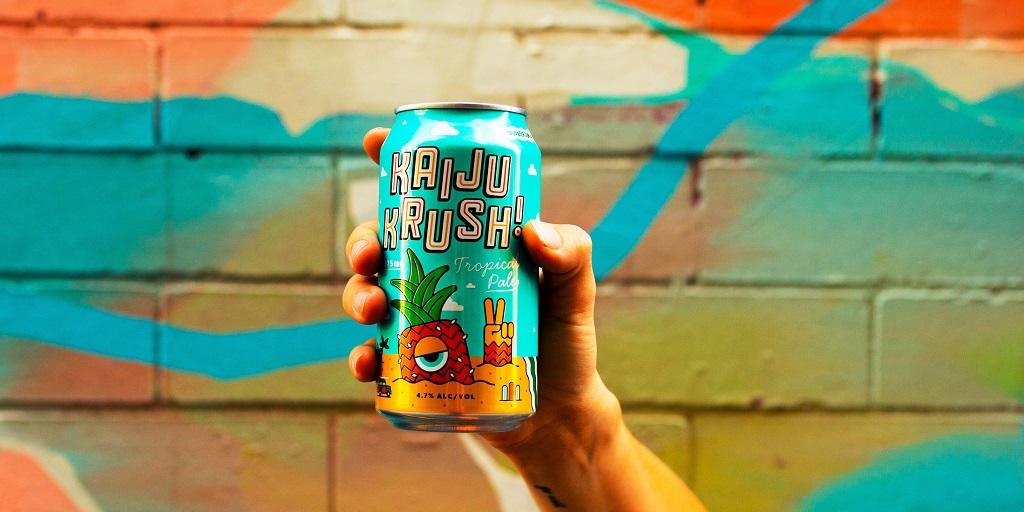
Krush boosts Kaiju success
Melbourne’s Kaiju Beer has started 2020 aiming to brew a million litres of beer this year and progress plans for a Melbourne taproom.
Callum Reeves, who founded Kaiju and Golden Axe cider with brother Nat in 2012, said the journey from cidermaker and contract brewer sharing space at Cavalier Brewing with Two Birds, to producing nearly 650,000 litres of beer last year, had been a major transition, but the team are fuelled for further growth.
Since moving into its own space, shared with Exit, Kaiju has funded a major expansion at the brewery, knocking through to another building which now houses its packaging operations.
The growth was enabled by the popularity of its beer in a wholesale setting – a challenging environment currently for any brewer.
“Dandenong is a good spot industrially, and it’s turned out reasonably well in that we’ve been able to expand, but there’s no opportunity for a taproom or cellar door arrangement here,” Reeves said.
While Kaiju can’t invest in a taproom where they are in a heavily industrialised area of Dandenong, it is working on plans for a brewpub which should come to fruition this year.
“At the moment we’re working on a taproom project. It will hopefully be in the suburbs of Melbourne, and I’m very excited to have a home for the brand, for people to come and engage with Kaiju.
“It has been missing and we haven’t had the money basically to work on it until recently.”
The industrial setting has however enabled Kaiju to grow to the point where the brewery now has a maximum capacity of around 1.5 million litres a year.
Reeves said it was the popularity of its Kaiju Krush tropical pale ale, launched in 2016, that was a factor driving this success.

Kaiju founders Callum and Nat Reeves
Going sessionable
Reeves said that bestseller Krush was born in a perfect storm.
“At about the end of 2015, beginning of 2016, the can thing really took off,” he explained.
“Nat then texted me about the idea for Krush, and the idea was born over the space of a few text messages, me and Nat texting back and forth, super excited for this idea. “
He said the product development of Krush, which was lower in alcohol than other beers (its first coming in below 5% abv) and slightly less hoppy than previous beers that the brewery made, wasn’t all easy.
“That first batch of Krush, we were working with new equipment, working with a canning line rather than bottling line, it was really tricky – but we figured it out and that started selling really well.”
He said its popularity has been prompted by a rise in health-conscious consumers looking for lower alcohol beer (like its Main Squeeze 3.2% beer) which has given rise to non alcoholic, low alcohol and generally more sessionable beers.
These have previously been the province of the bigger brewers, but independents such as Brick Lane Brewing,Sobah and Balter – prior to its sale to CUB – among many others are following suit.
“[With Krush] we wanted something we can drink every day,” Reeves explained.
“As you get older you become a bit more interested in your health, or I have anyway, and you care more about what goes into your body. So it’s not a bad thing for breweries to be trying to reduce the alcohol in their beers.”
He said it was part of a wider industry trend to get on board with consumer demands.
“I do think it’s an industry-wide thing. We’re seeing more breweries come out with lower alcohol [options]. Look at the success of the big breweries’ lower-alcohol brands like Great Northern, the growth of that is crazy.
“On an international stage, lower and no alcohol is big. You see things like kombucha, it’s big because fermentation gives flavour, even if it’s not an alcoholic fermentation and it does still add that something that’s really satisfying on your palate without alcohol.
“For me, I want something that has flavour but that I can continue to drink. You can stay relatively responsible and enjoy that, get that refreshment and feel ok the next day.”
He said that while Krush was Kaiju’s first move towards lower alcohol beers and proved exceptionally popular, it wasn’t a case of putting all Kaiju’s eggs in one basket.
“We’re always going into new product development – the brewers would go crazy without that.
“I think they really do love the challenge of hitting numbers that they need to with Krush and the other beers, but working on new things really informs what new products you come out with and also other skills you might need to work on, and it keeps it interesting for the brewers.”
He said its 3.2% abv session ale with passionfruit and guava juice, Main Squeeze, was also proving popular and fitted in with evolving drinking habits.
“I love drinking or sharing those big beers, but I’ll have one of those and then water or Krush or Main Squeeze.
“The fruit adds a bit of interest to the flavour. You can get such satisfaction out of a beer that’s 3.2% alcohol, that’s a big thing for us.”
Design challenges
Part of Kaiju’s success has been its distinct design.
New York-based artist Mikey Burton has been behind many of Kaiju’s iconic packaging designs, who the Reeves brothers contacted through a recommendation from Callum’s wife Clara.
She was a pivotal player in the brand creation process, having a background in graphic design and computer games, helping Burton and helped the team develop a strong identity for the brand.
Kaiju have their artwork pre-vetted by ABAC, including its Krush, Main Squeeze and Golden Axe cider, but have never received a complaint or had any issues raised about its branding or advertising, outside of voluntary pre-vetting.
“Some retailers don’t stock your products without the pre-vetting. We know we’ve come up in the past… and we’ve had more trouble on some of our cans in regards to how broadly attractive our designs are… so we do it as part of our new product development,” Reeves explained.
Krush’s initial packaging underwent subtle changes to comply with the code, but Reeves is still proud of the look with designer Mikey Burton’s art a major element of their branding.
Reeves said that Burton and the Kaiju team consider the ABAC regulations a design challenge and a necessary obligation.
“We think of it as a design challenge. There was a situation where we had a tight timeframe on getting a design that would work, and to the credit of ABAC, when we said we had a situation where we really need to get it sorted out as quickly as possible, the prevetters have been super timely in their responses.
“What they’re doing is applying the code, they do get that this is real and these are peoples’ real jobs.
“It’s good to be in a situation where we don’t have to worry about that.”
Kaiju’s growth over the past few years has meant it has had to focus on top level issues like ABAC and upscaling, but Reeves said that they wouldn’t be resting on their laurels anytime soon.
“It’s one project after another, so when you ask how much further we want to grow, I can’t stand it when I don’t have a project and usually that involves growing, so the project might be resdesigning how the brewery works or increasing capacity.
“We’ve not grown at the fastest rate because we’ve had to do it basically bootstrapping the whole thing. We grow as much as we can and to demand and keep growing like that. We’ll see how we go!”




